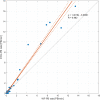Detection of Common Arrhythmias by the Watch-PAT: Expression of Electrical Arrhythmias by Pulse Recording
- PMID: 35478721
- PMCID: PMC9038202
- DOI: 10.2147/NSS.S359468
Detection of Common Arrhythmias by the Watch-PAT: Expression of Electrical Arrhythmias by Pulse Recording
Abstract
Background: The WatchPAT (WP) device was shown to be accurate for the diagnosis of sleep apnea and is widely used worldwide as an ambulatory diagnostic tool. While it records peripheral arterial tone (PAT) and not electrocardiogram (ECG), the ability of it to detect arrhythmias is unknown and was not studied previously. Common arrhythmias such as atrial fibrillation (AF) or premature beats may be uniquely presented while recording PAT/pulse wave.
Purpose: To examine the potential detection of common arrhythmias by analyzing the PAT amplitude and pulse rate/volume changes.
Patients and methods: Patients with suspected sleep disordered breathing (SDB) were recruited with preference for patients with previously diagnosed AF or congestive heart failure (CHF). They underwent simultaneous WP and PSG studies in 11 sleep centers. A novel algorithm was developed to detect arrhythmias while measuring PAT and was tested on these patients. Manual scoring of ECG channel (recorded as part of the PSG) was blinded to the automatically analyzed WP data.
Results: A total of 84 patients aged 57±16 (54 males) participated in this study. Their BMI was 30±5.7Kg/m2. Of them, 41 had heart failure (49%) and 17 (20%) had AF. The sensitivity and specificity of the WP to detect AF segments (of at least 60 seconds) were 0.77 and 0.99, respectively. The correlation between the WP derived detection of premature beats (events/min) to that of the PSG one was 0.98 (p<0.001).
Conclusion: The novel automatic algorithm of the WP can reasonably detect AF and premature beats. We suggest that when the algorithm raises a flag for arrhythmia, the patients should shortly undergo ECG and/or Holter ECG study.
Keywords: WatchPAT; arrhythmia; atrial fibrillation; home sleep apnea test; obstructive sleep apnea.
© 2022 Pillar et al.
Conflict of interest statement
Giora Pillar is a consultant to Itamar-Medical, and has current research funding from DayZz, KeepMed and InnoBev and has received speaker fees from TEVA, Pfizer and Sanofi. Richard Berry has current research funding from Philips Respironics and Res Med. Thomas Penzel has received unrestricted grants from &gesund, Itamar, Löwenstein Medical, Philips/Respironics, Resmed and speaker fees from Inspire, Heel Pharma, Philips, and UCB; reports grants from Cidelec, personal fees from Bayer Healthcare, personal fees from Jazz Pharma, personal fees from Cerebra, personal fees from National Sleep Foundation, grants, personal fees from Löwenstein Medical, grants from Novartis, Shareholder from Advanced Sleep Research, Shareholder from The Siestagroup GmbH, Shareholder from Nukute, outside the submitted work. The authors report no other conflicts of interest in this work.
Figures






References
-
- Wang S, Cui H, Ji K, et al. Relationship between obstructive sleep apnea and late gadolinium enhancement and their effect on cardiac arrhythmias in patients with hypertrophic obstructive cardiomyopathy. Nat Sci Sleep. 2021;13:447–456. PMID: 33790677; PMCID: PMC8006971. doi:10.2147/NSS.S270684 - DOI - PMC - PubMed
-
- Safadi A, Etzioni T, Fliss D, Pillar G, Shapira C. The effect of the transition to home monitoring for the diagnosis of OSAS on test availability, waiting time, patients’ satisfaction, and outcome in a large health provider system. Sleep Disord. 2014;2014:418246. PMID: 24876974; PMCID: PMC4020217. doi:10.1155/2014/418246 - DOI - PMC - PubMed
LinkOut - more resources
Full Text Sources

